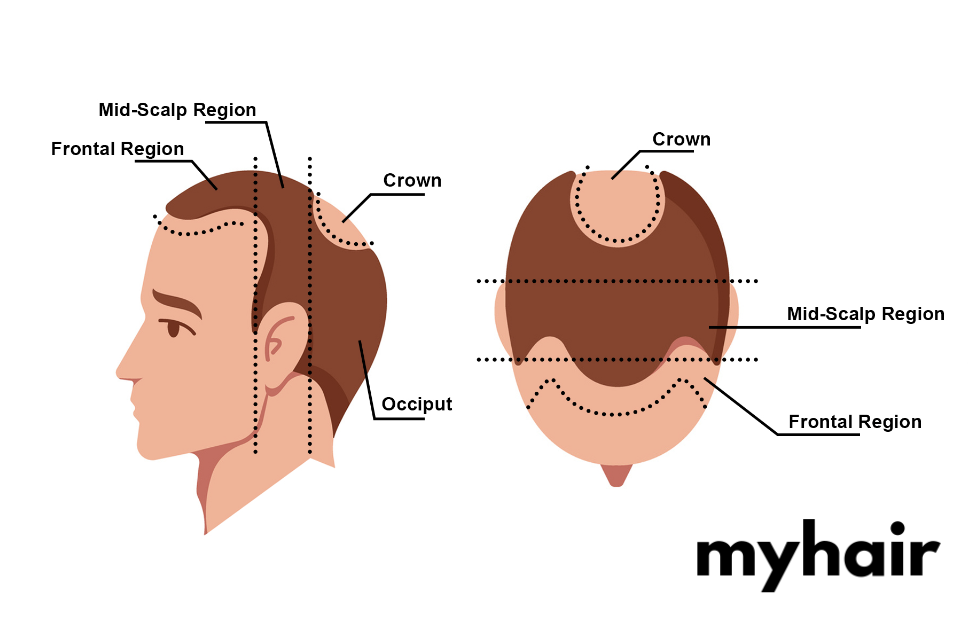If you’ve recently been diagnosed with androgenic alopecia, you’ve probably started to hear a lot of weird words thrown around – like ‘vertex’, ‘occiput’, or ‘forelock’. Whether you’ve read them on a minoxidil label or heard them when talking to your trichologist or dermatologist, these words are important. They refer to specific parts of the head that are more or less likely to be affected by the progression of pattern hair loss.
And before you start to wonder if you need to relearn the parts of the head – don’t worry. According to the book Advanced Surgical Facial Rejuvenation, there are only five major regions where hair grows on your head.
What are the parts of the scalp?
The scalp can easily be broken down into five main parts. It’s made up of the frontal region, temples, mid-scalp, crown, and occiput.

The scalp’s five main parts are the frontal region, temples, mid-scalp, crown, and occiput.
The frontal region and temples
The frontal scalp, or frontal region, refers to your hairline and the hairs that grow framing your face. Or, if you have a receding hairline, the frontal region is where your hairline used to be when you were a kid.
If your hairline now forms an M shape, you’re seeing hair loss along both the frontal region and your temples. The tip of that M shape – the front and center of the head, where some people have a widow’s peak – is called the mid-frontal point. That area is sometimes also referred to as the forelock or central forelock.
The M shape that occurs when people lose hair due to androgenic alopecia specifically affects the frontotemporal corners of your scalp. These are the borders between the frontal scalp and your temples, which are toward the side of your head.
You might think of your temples as the spots on each side of your head that hurt when you have a headache. But in terms of scalp anatomy, the temples are much larger. They border either side of the frontal region, running down the sides of your head about halfway past your ears.
Just below the frontotemporal corner – below where you’d rub your temple if you had a headache – is the temporal point. The hair around the temporal point runs along the sides of your head along your hairline and stops before your ears. Most people with androgenic alopecia won’t lose the hair that grows just above their ears. This hair runs along the bottom half of the temporal point and temples and connects to the occiput, which is a fancy name for the back of the head.
The mid-scalp
The mid-scalp (or midscalp) is the part of the scalp between the frontal scalp and crown. People only experience hair loss in this region when they have allowed androgenic alopecia to progress into its later stages. This is one of the last places you’ll lose hair before you become fully bald.
The mid-scalp is separated from the crown by the vertex transition point toward the back, but there’s no frontal transition point at the front. However, you can easily imagine where the mid-scalp ends and your frontal scalp begins, thanks to your temples. If your temples continued to run along the top of your head (like a girl’s headband), that’s roughly the border that would separate your front and mid-scalp regions.

The mid-scalp and crown are separated by the vertex transition point.
The vertex
The crown of the head – also called the vertex – is one of the main places men lose hair when experiencing androgenic alopecia. As symptoms progress, vertex baldness is one of the main issues people with pattern hair loss try to hide. It’s also the main area where topical hair loss products like minoxidil are meant to be applied.
The crown is a circular region at the top of the head, all the way toward the back. It borders the mid-scalp. These two regions are divided by the vertex transition point, where your head starts to slope upward toward the flatter top of your head.
The occiput
The word occiput technically refers to the back of the head. However, when talking about different areas of the head, the occiput really refers to the lower back and sides of your scalp. It’s the largest of all the head regions and is the main area where hair follicles are harvested for use in hair transplant surgeries. Hair growing in the occiput is mostly unaffected by the progression of pattern hair loss.
The occiput shares a border with the temple regions along the sides of your head. This means that it starts about halfway along your ears and covers the entire lower back of your scalp. Imagine drawing a line from the frontotemporal corner of your scalp all around the back of your head. After passing the temple region, that line would cover the entire occiput (plus part of the crown), until you reach the temple region on the other side of your head.
The upper back of your head is where the occiput borders the crown. The crown of your head is the point of transition from the top of the head to the point where it starts to slope down.
What are the parts of the head affected by hair loss?
The human head is made up of five key regions: the frontal region, temples, mid-scalp, vertex, and occiput. Out of these areas, the frontal region, mid-scalp, and vertex are the areas most affected by the progression of androgenic alopecia. The temples and occiput are also affected, but most people retain at least half to two-thirds of the hair growing on these parts of the scalp.
If you’re trying to stop yourself from going bald, you likely want to start a hair loss treatment before you lose too much hair around the frontal region and vertex of your head. People who are still experiencing the early stages of pattern hair loss can benefit from topical treatments like minoxidil or devices like laser hair therapy caps.
If your hair loss progresses, you’ll start to lose hair from the mid-scalp region of your head. This region will get smaller and thinner, making both your frontal scalp and crown of your head look larger over time. This is a sign of later-stage pattern hair loss and is much harder to treat. People with this type of hair loss usually need to explore surgical options, like hair loss transplants.
If you treat hair loss early, you may not need a transplant. Instead, you could use an FDA-approved treatment like minoxidil or low-level laser therapy. Both of these solutions can stop hair loss and help improve hair regrowth.





